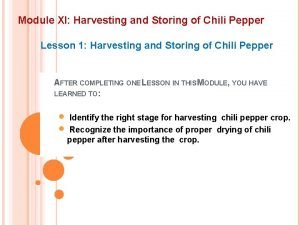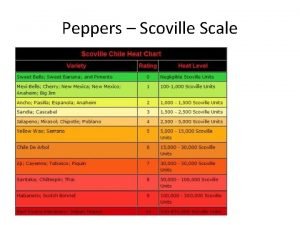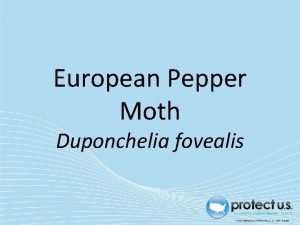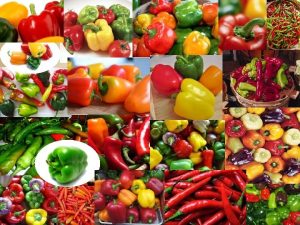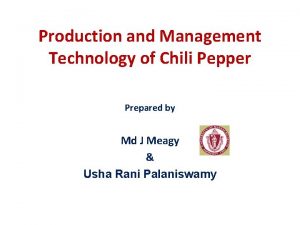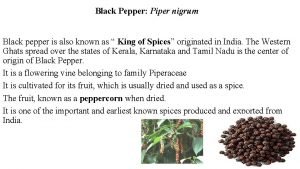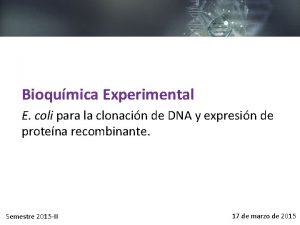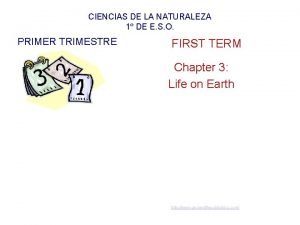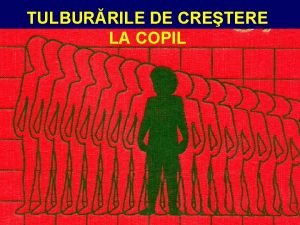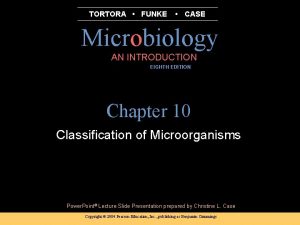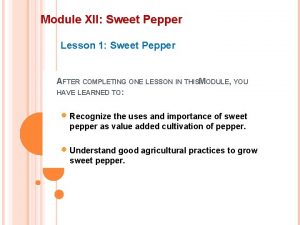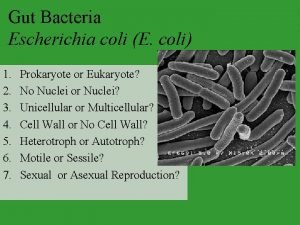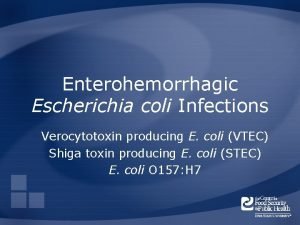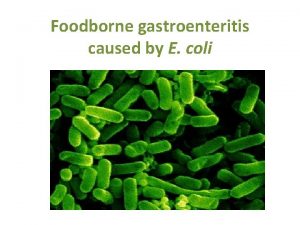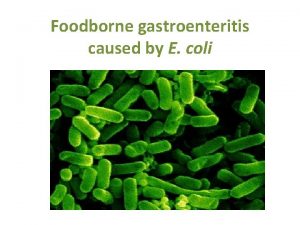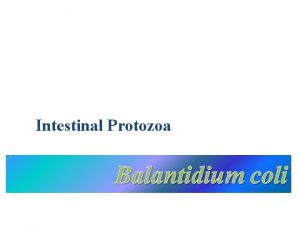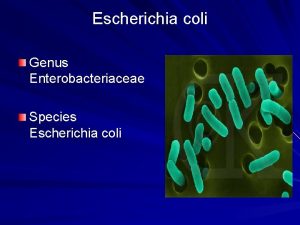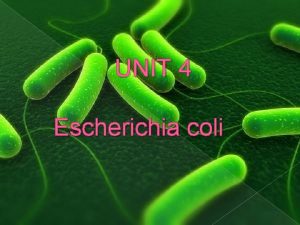The Effects of Pepper Oil on E Coli


























- Slides: 26

The Effects of Pepper Oil on E. Coli Survivorship Nicola R. Fratto Grade 11 Central Catholic High School

Background Part One

Escherichia coli • Major cause of food-borne illness • Consumption of undercooked meats • Consumption of contaminated vegetables or unpasteurized milk • Also resides in fecal matter • Most studied bacteria in the world and very commonly used in the lab • Resides in the digestive tract of animals • Not all strains of E. coli can result in sickness or disease • Gram-negative bacteria

Black Pepper • Piper nigrum • Most common spice in the world • Used on almost every savory food as a spice

Chili Pepper • Dozens of types of chili pepper • Capsaicin oil gives spice • Tested chili oil variable was 100% pure capsaicin oil from a chili pepper

Cayenne Pepper • Type of chili pepper • Tested cayenne oil variable was 100% pure capsaicin from cayenne peppers

Experiment Part Two

Rationale for Experiment: Usually, when an ingested material is used as a variable, its effects on the human that ingested it are recorded and observed. This experiment deals with the ingested material’s effect on the flora of the human body.

Hypotheses: Null: The examined variable will have no effect on the growth of E. coli outside of chance. Alternative: Caffeinated and decaffeinated coffee will significantly affect growth.

Purpose To determine the effects of various pepper oils on the human coliform E. coli

Materials • E. coli • Bunsen Burners • Latex Gloves • Spread Bar • Micropipettes • Incubator 50 LB • Micro tubes agar plates • Black Pepper Oil • Ethanol • Chili Pepper • Matches • Cayenne Pepper Oil • Vortex • Sterile Dilution Fluid

Procedure 1. Materials were gathered. 2. Concentrations of variable were made. 3. Bacteria at a density of 50 Klett Spectrophotometer density was added. 4. Solutions were inverted for approximately 15 minutes by hand. 5. Solutions were synchronously plated on LB agar plates. 6. Plates incubated over night. 7. Plates were taken home next day and colonies were counted. It was assumed that a single colony arose from a single cell.

Chart of Concentrations Control 0. 1% 1% 10% E. coli 0. 1 ml Sterile Dilution Fluid (SDF) 9. 9 ml 9. 8 ml 8. 9 ml Oil 0 ml 0. 01 ml 0. 1 ml Total Volume 10 ml

Stats Part Three

Stat Analysis ANOVA Dunnetts Test • Shows if there is any variations • Shows the variation between a between the mean of 2 or more control group and an variable groups experimental groups

Primary Statistical Analysis • Anova is first performed • F value of 43. 6 is greater than F-critical of 3. 23 • Dunnett’s Tests are performed • T-Critical of 3. 29

Secondary Statistical Analysis Black Pepper Concentration 0. 1% 1% 10% T-Value 5. 031 3. 678 3. 887 Significant? Yes Yes

Black Pepper Graph Black Pepper Oil 185 182. 2 180 verage Number of Colonies 180 175 170 168 165 160 0. 10% 1. 00% Percent Concentration of Black Pepper Oil 10. 00%

Secondary Statistical Analysis Chili Pepper Concentration 0. 1% 1% 10% T-Value 4. 117 2. 687 5. 622 Significant? Yes No Yes

Chili Pepper Graph Chili Pepper Oil 290 279. 8 verage Number of Colonies 280 270 264 260 249 250 240 230 0. 10% 1. 00% Percent Concerntration of Chili Pepper Oil 10. 00%

Secondary Analysis Cayenne Pepper Concentration 0. 1% 1% 10% T-Value 6. 022 2. 840 4. 288 Significant? Yes No Yes

Cayenne Pepper Graph Cayenne Pepper Oil 295 284 verage Number of Colonies 275 265. 8 265 250. 6 245 235 225 0. 10% 1. 00% Percent Concentration of Cayenne Pepper Oil 10. 00%

Conclusion • All pepper oils brought about significant change in E. coli survivorship at minimum and maximum concentration • Despite the insignificant 1% results from two of the variables, I believe all three of these oils are significantly detrimental to E. coli survivorship at any concentration.

Limitations • Variable may not have been plated in perfect sync. • Oil did not mix homogeneously for very long which made plating difficult. • Only three variables tested. • Only survivorship was assessed.

Expansion • Test with other peppers • Use different models • Synchronized effects

References • www 2. centralcatholichs. com/biology
 Primary emulsion
Primary emulsion Modules
Modules Jigsaw pepper scoville
Jigsaw pepper scoville Kris pepper
Kris pepper Galapagos pepper
Galapagos pepper Dr pepper advert
Dr pepper advert Reason code 39929
Reason code 39929 European pepper moth
European pepper moth Jackie robinson house pasadena
Jackie robinson house pasadena Salt and pepper chorioretinitis
Salt and pepper chorioretinitis Lucy pepper
Lucy pepper Pig and pepper alice in wonderland
Pig and pepper alice in wonderland Dr pepper puns
Dr pepper puns Jackie robinson ppt
Jackie robinson ppt What do pepper weevils look like
What do pepper weevils look like Chili pepper productions
Chili pepper productions John frusciante
John frusciante Workbook es contable o incontable
Workbook es contable o incontable Rapid multiplication technique in black pepper
Rapid multiplication technique in black pepper Entamoeba coli hospedero
Entamoeba coli hospedero Is e coli unicellular or multicellular
Is e coli unicellular or multicellular Czy sprite jest zdrowy
Czy sprite jest zdrowy Escherichia coli unicellular or multicellular
Escherichia coli unicellular or multicellular Regio cervicalis anterior
Regio cervicalis anterior Boda coli
Boda coli Sindromul marfan imagini
Sindromul marfan imagini Phage typing
Phage typing

